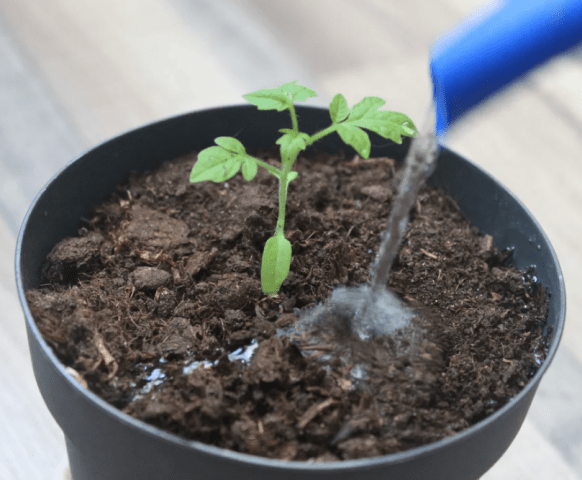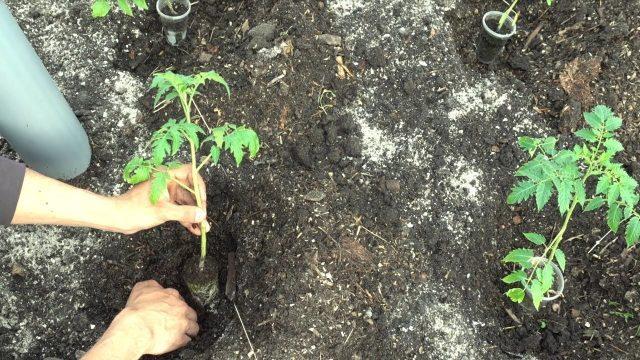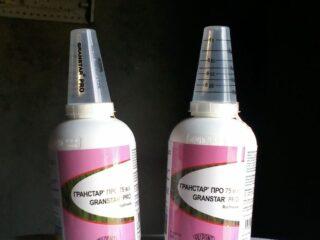Content
- 1 Is it possible to feed tomato seedlings with ammonia?
- 2 When is fertilizer needed?
- 3 Advantages and disadvantages
- 4 How to dilute ammonia for watering tomato seedlings
- 5 How to fertilize tomato seedlings with ammonia
- 6 Treatment of tomato seedlings with ammonia against pests
- 7 Precautionary measures
- 8 Conclusion
- 9 Reviews on the use of ammonia for tomato seedlings
Without regular fertilizing, it is extremely difficult to get a good harvest of tomatoes. In the early stages of development, plants especially need nitrogen. To provide them with this macronutrient, mineral fertilizers or natural organic matter are applied. But there are also less traditional sources of nitrogen, for example, an aqueous solution of ammonia. This is a fairly aggressive chemical, so you need to know how to use ammonia for tomato seedlings correctly, otherwise the plants may die.
Is it possible to feed tomato seedlings with ammonia?
Ammonia is a 10% (less often 25%) aqueous solution of ammonia. It contains nitrogen, and in a form that is quickly and easily absorbed by plants and does not require preliminary processing by microorganisms living in the soil.
Tomatoes react negatively to a deficiency of this macronutrient already at the stage of growing seedlings.Seedlings develop slowly and turn out stunted and frail. Obviously, one cannot expect a good harvest from them. An ammonia aqueous solution for tomato seedlings is one of the effective ways to provide them with nitrogen.

High-quality tomato seedlings are the key to a good harvest
When is fertilizer needed?
A lack of nitrogen and, accordingly, the need to feed tomato seedlings with an ammonia solution is clearly indicated by its appearance. Characteristic symptoms:
- pale green or yellowing existing leaves (starting from the lowest);
- small and/or deformed leaf blades that grow back;
- thin, brittle stems, unnaturally long leaf cuttings;
- slow rate of development of seedlings or even cessation of their growth.

Seedlings with nitrogen deficiency exhibit increased sensitivity to negative external influences
Advantages and disadvantages
Ammonia as a fertilizer for tomato seedlings has significant advantages:
- Nitrogen in the form contained in ammonia is easily absorbed by plants. The process of restoring health after such feeding is faster than after applying mineral fertilizers, most of which have a cumulative effect.
- Ammonia is not only a nitrogen fertilizer, but also a means for disinfecting soil in containers. It effectively destroys pathogenic microflora, eggs and larvae of pests.
- If ammonia is used correctly as a top dressing, it is absolutely harmless to tomato seedlings and neighboring plants on the windowsill.
- Ammonia is sold in almost any pharmacy. It is much more affordable in price than mineral nitrogen fertilizers.
- It is not difficult to prepare the working solution; use it immediately.There is no need to wait for it to brew or otherwise waste time.

Feeding tomato seedlings with ammonia is a fairly popular method among gardeners to compensate for nitrogen deficiency.
Naturally, the method also has certain disadvantages:
- If you overdose on ammonia, an overly concentrated solution will simply burn the roots of tomato seedlings and the seedlings will die.
- Ammonia is a highly toxic chemical with pronounced volatility. If you neglect safety measures when working with it, feeding tomato seedlings can simultaneously become a source of serious harm to the health of the gardener.
- With regular use, ammonia gradually increases the acidity of the soil. If you limit yourself to one fertilizing for tomato seedlings, the change in pH will be almost imperceptible, but when the gardener continues to water throughout the season, it already becomes obvious. You also need to take into account that there are varieties and hybrids of tomatoes that are more sensitive to the level of soil acidity than others. The situation is even worse if, contrary to the rules of crop rotation, the gardener plants a crop in one place for several seasons in a row.
How to dilute ammonia for watering tomato seedlings
The concentration of ammonia solution for tomato seedlings is 1 ml/l. Preparing fertilizing is extremely simple. The required volume of the chemical is added to water at room temperature and stirred vigorously for 1-2 minutes.

Prepare the solution immediately before use: the chemical is very volatile
How to fertilize tomato seedlings with ammonia
The preferred method of fertilizing tomato seedlings with ammonia is root feeding.When spraying seedlings with its solution, chemical and sunburn may remain on the leaves. In addition, the risk of developing rot increases.
When sowing seeds
Gardeners who practice fertilizing with ammonia during sowing first water the soil well about an hour before the procedure. Then, 10-15 minutes before planting, literally 2-3 drops of ammonia solution are dripped into each hole.

Tomato seeds are large enough to be planted immediately in individual containers or in separate holes
Feeding seedlings
Feeding tomato seedlings with a solution of ammonia when sowing seeds in a common container is carried out at least two weeks after picking. If they were planted individually, not before the second pair of true leaves is fully formed on the seedlings.
First, the soil is well shed with plain water. Then root feeding of tomato seedlings is carried out with an ammonia solution, using 30-50 ml of liquid for each seedling.

The volume of solution per seedling is determined depending on the rate of development and general tone
After planting seedlings in open ground
Tomatoes in open ground or in a greenhouse can continue to be fed with ammonia solution. Its concentration does not change. Before the formation of buds and the start of flowering, gardeners have time to carry out another 2-3 root feedings with ammonia. The first - approximately 4-5 days after transplanting the tomato seedlings into the ground and then - at intervals of about a week and a half.
During the formation of fruit ovaries and fruiting, any nitrogen-containing fertilizing is carried out in exceptional cases. Tomatoes can be treated with a standard concentration of ammonia solution if:
- Their appearance clearly indicates nitrogen starvation. The bushes are sprayed at intervals of 7-8 days until positive dynamics appear.
- The fruits of late-ripening varieties and hybrids will not ripen until the first frost. To activate the ripening process, tomatoes are watered with ammonia 2-3 times with an interval of 3-5 days.

Immediately after planting, fertilizing is excluded; the seedlings must adapt to the new place
Treatment of tomato seedlings with ammonia against pests
In order to get rid of pests on tomato seedlings, the concentration of the ammonia solution is increased to 2-3 ml/l of water. The seedlings are sprayed with liquid from a fine spray bottle, paying special attention to the underside of the leaves. The soil in the container is also treated.
When tomato seedlings are affected by pests, the problem can usually be noticed at an early stage. Therefore, 1-2 procedures with an interval of 7-10 days are enough to get rid of unwanted insects.
Precautionary measures
Ammonia is a harsh and volatile chemical. Even short contact with its vapors can cause serious harm to health, including irritation of the mucous membranes of the eyes, nose, mouth, burns of bronchial and lung tissues.
Therefore, it is impossible to work with ammonia without using personal protective equipment. They are used not only during the processing of tomato seedlings.The minimum set is thick rubber gloves, goggles that fit securely to the skin, and a special respirator that protects against fumes.

Personal protective equipment is put on when starting to prepare the solution, and removed only after disposal of its remains.
It is also necessary to protect the skin as much as possible from contact with the solution. To do this, wear closed, waterproof shoes, clothes made of thick fabric with long sleeves and trousers.
Other basic rules for those who want to water tomato seedlings with ammonia:
- Prepare the solution only in household containers in which food, drinking water is not stored, or food is not prepared.
- Dilute ammonia with water outdoors or in a room with good ventilation and open windows.
- While preparing the solution and feeding, do not eat, drink, or smoke.
- Reliably isolate children and pets from the place of work and ammonia itself.
- At the end of the procedure, wash your face, take a shower, and wash your work clothes as quickly as possible.
The following symptoms indicate ammonia poisoning:
- severe pain, burning in the eyes;
- redness and swelling of the mucous membranes of the eyes, nose and mouth;
- incessant lacrimation, nasal discharge;
- spasms, sore throat;
- breathing problems (feeling of shortness of breath, suffocation);
- severe coughing attacks;
- redness, rash, skin irritation, severe itching;
- nausea, vomiting;
- dizziness, feeling of a borderline state of consciousness, migraine.
Any of these symptoms that appear during or after processing tomato seedlings is a reason to immediately go to the hospital, and in especially severe cases, call an ambulance.Delay in this case means worsening harm to health, up to irreversible consequences.
Conclusion
Those wishing to use ammonia for tomato seedlings should first study the rules for preparing the working solution and all the important nuances of its use, including precautions. It is an effective nitrogen fertilizer, which has more advantages than disadvantages, but at the same time it is an aggressive chemical that can cause serious harm to health and burn the roots of young seedlings.
Reviews on the use of ammonia for tomato seedlings








